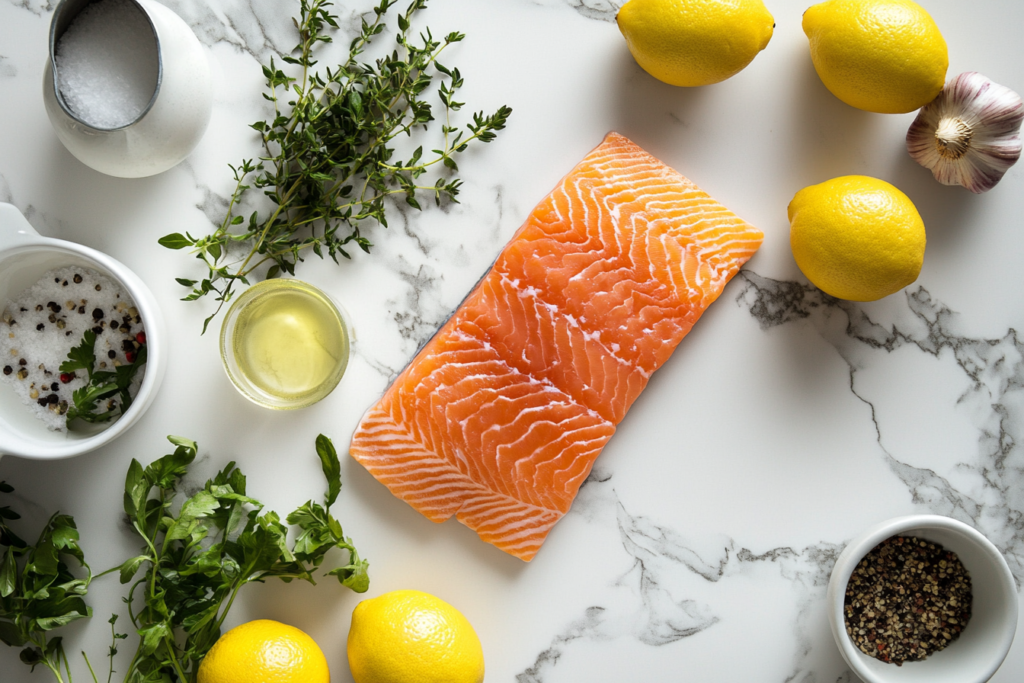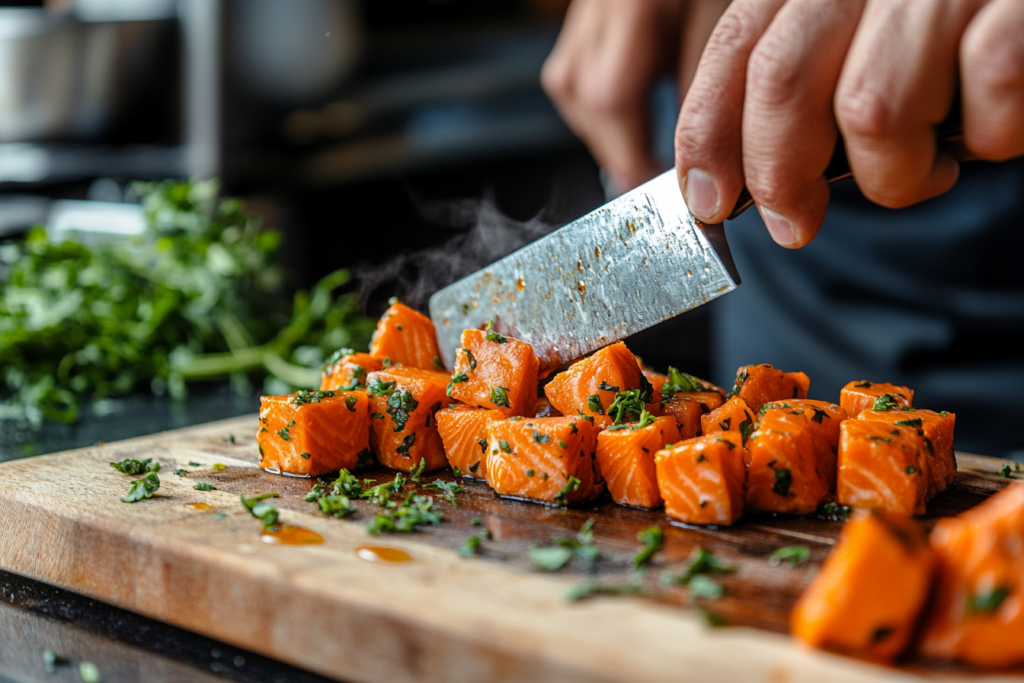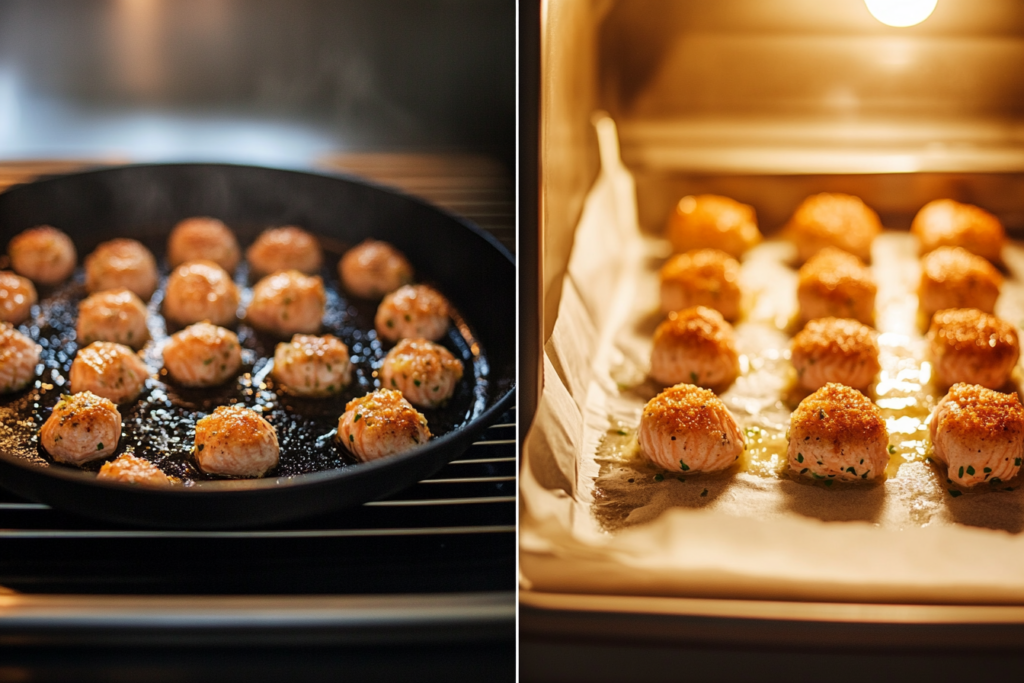Table of contents
- What Are Salmon Bites? Defining Salmon Bites
- Ingredients for the Perfect Salmon Bites: Fresh Salmon – What to Look For
- How to Prepare Salmon for Bites: Step-by-Step Preparation Guide
- Cooking Methods for Salmon Bites: Pan-Seared vs. Oven-Baked Salmon Bites
- Salmon Bites Variations: Unique Variations to Try
- Common Questions About Salmon Bites
- Conclusion: Perfect Salmon Bites Every Time
What Are Salmon Bites? Defining Salmon Bites
A salmon bites recipe features small, bite-sized pieces of salmon that are seasoned, marinated, and cooked to perfection. These versatile bites are perfect for any occasion, from casual snacking to elegant gatherings.
Why Choose Salmon for Bites? Health Benefits of Salmon
Salmon is the star ingredient in any salmon bites recipe, thanks to its numerous health benefits. Here’s why:
1. Rich in Omega-3 Fatty Acids
Salmon is renowned for its high content of omega-3 fatty acids, which support heart health, reduce inflammation, and promote brain function.
2. High-Quality Protein
Salmon provides a complete source of protein, essential for muscle repair, growth, and overall body function.
3. Packed with Essential Nutrients
Salmon is a great source of vital nutrients such as vitamin B12, vitamin D, and selenium, which support energy production, immune function, and bone health.
4. Supports Heart Health
Consuming salmon regularly can help reduce the risk of heart disease by improving cholesterol levels and lowering blood pressure.
5. Versatility in Preparation
Salmon’s firm texture and rich taste make it ideal for various cooking methods, ensuring flavorful bites every time.
By choosing salmon for bites, you combine gourmet appeal with exceptional health benefits, making it a standout choice for any occasion.
Ingredients for the Perfect Salmon Bites: Fresh Salmon – What to Look For
When creating a great salmon bites recipe, fresh salmon is key. Combine it with the right herbs, spices, and seasonings for a flavorful and nutritious dish., keep the following points in mind:
- Appearance: Look for salmon fillets or cuts that are vibrant in color, ranging from pink to orange, with a moist, glistening surface.
- Smell: Fresh salmon should have a mild, ocean-like scent. Avoid fish with an overly “fishy” or sour smell.
- Texture: The flesh should be firm to the touch and bounce back when gently pressed.
- Source: Opt for wild-caught salmon or sustainably farmed options for the best flavor and environmental impact.
Choosing fresh salmon ensures your bites will be flavorful, tender, and of the highest quality.

Key Ingredients for a Tasty Salmon Bite: Herbs, Spices, and Seasonings
To elevate the natural flavor of salmon, the right combination of herbs, spices, and seasonings is essential. Consider incorporating these key ingredients:
Essential Seasonings
- Salt and Pepper: The basics that enhance salmon’s natural flavor.
- Paprika: Adds a smoky, slightly sweet kick.
- Garlic Powder: Boosts the savory depth of your bites.
- Lemon Zest: Brings a bright, citrusy note that complements salmon.
Herbs
- Dill: A classic pairing with salmon, offering a fresh, slightly tangy flavor.
- Parsley: Adds a mild, herbaceous touch.
- Cilantro: For a zesty, slightly citrusy taste.
Optional Extras
- Chili Flakes: For a bit of heat.
- Honey or Maple Syrup: A hint of sweetness to balance spices.
Adding Vegetables for Extra Flavor: Onions, Garlic, and More
Enhancing salmon bites with vegetables introduces additional layers of flavor and texture. Here are some popular options:
- Onions: Finely chopped or caramelized onions add sweetness and a savory undertone.
- Garlic: Minced or roasted garlic provides a bold and aromatic flavor.
- Bell Peppers: Dice them small for a crunch and a hint of sweetness.
- Green Onions or Chives: These contribute a mild, fresh onion flavor.
- Lemon Slices: Add during cooking to infuse a tangy zest.
Including vegetables not only enriches the flavor but also boosts the nutritional value of your salmon bites, making them even more irresistible.
How to Prepare Salmon for Bites: Step-by-Step Preparation Guide
Preparation is crucial for a successful salmon bites recipe. Start by cutting the salmon into even pieces and marinating them with your favorite flavors.

Cutting the Salmon into Perfect Bites: How to Slice Salmon Properly
- Select the Right Cut of Salmon
Choose a fresh, boneless fillet or portion of salmon. Ensure the skin is removed unless you prefer crispy skin on your bites. - Use a Sharp Knife
A sharp, flexible knife is essential for clean, precise cuts that prevent tearing the salmon. - Chill the Salmon
Briefly chill the salmon in the freezer for 10–15 minutes to firm it up, making it easier to slice. - Cut into Uniform Pieces
- Place the salmon fillet on a cutting board.
- Slice into 1–2-inch cubes, ensuring they are uniform in size for even cooking.
- Trim any uneven or thin sections to avoid overcooking.
Proper slicing guarantees tender, bite-sized pieces that cook evenly.
Marinating the Salmon: Choosing the Right Marinade for Flavor
Marinating is the key to infusing salmon bites with robust flavor. Here’s how to do it:
- Choose Your Marinade Base
Select an oil or liquid that complements salmon’s rich taste:- Olive Oil: Adds richness and helps distribute other flavors.
- Soy Sauce: For a savory, umami kick.
- Citrus Juice (Lemon, Lime, or Orange): Brings brightness and a touch of acidity.
- Add Flavor Boosters
- Herbs and Spices: Dill, garlic, paprika, or chili flakes.
- Sweeteners: Honey, maple syrup, or brown sugar to balance acidity.
- Aromatics: Fresh ginger or minced garlic for depth.
- Marinate the Salmon
- Combine marinade ingredients in a bowl or zip-top bag.
- Add the salmon pieces, ensuring they are evenly coated.
- Marinate for 15–30 minutes in the refrigerator (avoid longer times to prevent the acid from breaking down the salmon’s texture).
- Pat Dry Before Cooking
Remove excess marinade to achieve a nice sear or crisp exterior during cooking.
By following these steps, you’ll ensure your salmon bites are flavorful, tender, and ready for cooking perfection.
Cooking Methods for Salmon Bites: Pan-Seared vs. Oven-Baked Salmon Bites
This section of your salmon bites recipe explores two popular methods: pan-searing for a crispy finish or baking for a healthier alternative:

Pan-Seared Salmon Bites
- Advantages:
- Quick and efficient.
- Creates a crisp, golden crust on the outside while keeping the inside tender.
- How-To:
- Heat a non-stick or cast-iron skillet over medium-high heat with a drizzle of oil.
- Add the salmon bites in a single layer, avoiding overcrowding.
- Cook for 2–3 minutes per side until golden and cooked through.
Oven-Baked Salmon Bites
- Advantages:
- Healthier, requiring less oil.
- Even cooking with minimal supervision.
- How-To:
- Preheat the oven to 400°F (200°C).
- Arrange salmon bites on a baking sheet lined with parchment paper or a lightly greased rack.
- Bake for 10–12 minutes, or until the salmon is opaque and flakes easily with a fork.
Choose pan-searing for a quick, crispy option or oven-baking for a hands-free, healthier alternative.
The Best Way to Cook Salmon Bites: Achieving the Perfect Crispiness
Crispiness is often a sought-after quality in salmon bites. Here’s how to achieve it:
- Dry the Salmon
Pat the salmon cubes dry with paper towels before cooking. This step removes excess moisture, allowing for better browning. - Use the Right Coating
- Lightly dust with flour or cornstarch for a crispy exterior.
- For extra crunch, coat with breadcrumbs or crushed nuts.
- Heat the Pan Properly
If pan-searing, ensure the skillet is hot before adding the salmon. This prevents sticking and ensures a good sear. - Avoid Overcrowding
Cook the salmon in batches if necessary, ensuring space between each piece for even browning. - Finish with a Broil (Optional)
For oven-baked bites, broil them for the last 1–2 minutes to add a crispy finish.
Following these tips will result in perfectly crispy salmon bites every time.
Grilling Salmon Bites: How to Grill Salmon Bites to Perfection
Grilling adds a smoky flavor and charred texture that enhances the taste of salmon bites. Here’s how to do it:
- Prepare the Grill
- Preheat the grill to medium-high heat.
- Lightly oil the grates to prevent sticking.
- Skewer the Salmon
- Thread salmon bites onto skewers for easy handling. If using wooden skewers, soak them in water for 20–30 minutes to prevent burning.
- Cook the Salmon
- Place the skewers directly on the grill.
- Grill for 2–3 minutes per side, turning carefully to avoid breaking the bites.
- Look for a slight char while ensuring the interior remains tender.
- Enhance with a Basting Sauce
Brush the salmon bites with a glaze or sauce during the final minute of grilling for an extra layer of flavor.
Grilling salmon bites offers a unique taste and is perfect for outdoor gatherings or adding a smoky flair to your meal.
Salmon Bites Variations: Unique Variations to Try
Experiment with your salmon bites recipe by adding spicy seasonings or sweet glazes for unique flavors that suit any palate.
Spicy Salmon Bites: Adding Heat with Spices
For those who enjoy a fiery kick, spicy salmon bites are a must-try. Here’s how to infuse heat into your bites:
- Seasoning Options
- Chili Powder or Cayenne Pepper: Sprinkle evenly for a consistent heat level.
- Smoked Paprika: Adds a smoky depth along with mild heat.
- Sriracha or Hot Sauce: Mix into a marinade or drizzle on top after cooking.
- Crushed Red Pepper Flakes: Sprinkle for an extra pop of spice.
- Cooking Tips
- Pair the spice with cooling elements like a yogurt-based dip or fresh cucumber slices.
- Balance the heat by including honey or maple syrup in the marinade to create a sweet-spicy profile.
Spicy salmon bites are bold and flavorful, perfect for those who enjoy a little excitement on their plate.
Sweet and Savory Salmon Bites: Incorporating Sweet Glazes and Sauces
For a delightful combination of flavors, try sweet and savory salmon bites. The natural richness of salmon pairs beautifully with sweet glazes and sauces.
- Sweet Glaze Options
- Honey Garlic Sauce: Combine honey, minced garlic, soy sauce, and a splash of lemon juice for a sticky glaze.
- Maple Soy Glaze: Mix maple syrup, soy sauce, and a pinch of ginger for a sweet-savory coating.
- Teriyaki Sauce: A classic choice for its balance of sweet, salty, and umami flavors.
- Preparation Tips
- Brush the glaze onto the salmon bites during the last few minutes of cooking to prevent burning.
- Garnish with sesame seeds or chopped green onions for added texture and flavor.
Sweet and savory salmon bites are a crowd-pleasing option, perfect for appetizers, snacks, or even a main course.
Experimenting with these variations allows you to explore the endless possibilities of salmon bites, ensuring there’s always a new and exciting way to enjoy this delicious dish.
Related Articles You Might Love
For those exploring other delicious recipe options, you might find inspiration in our Branzino Recipe Easy Cooking Guide, a perfect complement to seafood lovers. Additionally, if you’re interested in breakfast ideas that pair well with savory salmon bites, check out the Baked Scrambled Eggs with Cheese Recipe for a delightful combination. For a unique side dish, consider our Dense Bean Salad Easy Recipe, which brings a refreshing and healthy balance to any meal.
Common Questions About Salmon Bites
When working on your salmon bites recipe, you may wonder about the best sauces, oils, and seasonings to use. We’ve got you covered with expert tips.. Here are answers to some frequently asked questions:
What Sauce Goes on Salmon?
The type of sauce you choose for salmon can greatly enhance its flavor. Here are some popular options:
- Classic Sauces
- Lemon Butter Sauce: A rich and tangy blend of melted butter, fresh lemon juice, and garlic.
- Creamy Dill Sauce: Made with yogurt, sour cream, or mayonnaise, mixed with dill and a touch of lemon.
- Sweet and Savory Sauces
- Teriyaki Sauce: Balances sweet, salty, and umami flavors, perfect for an Asian-inspired touch.
- Honey Mustard Glaze: Combines the sweetness of honey with the tang of mustard for a balanced flavor.
- Spicy Sauces
- Sriracha Mayo: A creamy, spicy condiment with a touch of heat.
- Chili Lime Sauce: Combines fresh lime juice with chili for a zesty, spicy kick.
Pairing the right sauce with salmon enhances its natural richness and creates a perfect balance of flavors.
Should I Use Butter or Oil for Salmon?
Both butter and oil work well for cooking salmon, and your choice depends on the flavor and cooking method you prefer:
- Butter
- Adds richness and a slightly nutty flavor when browned.
- Ideal for pan-searing or baking when you want a silky finish.
- Oil
- A neutral oil (like canola or avocado) works well for high-heat cooking like grilling or roasting.
- Olive oil adds a mild, fruity flavor and pairs beautifully with salmon.
Tip: For the best results, use a combination of both. Start cooking with oil for its high smoke point and finish with butter for flavor.
What Does Gordon Ramsay Season Salmon With?
Chef Gordon Ramsay is known for his flavorful yet simple approach to seasoning salmon. He often uses:
- Basic Seasoning
- Sea salt and freshly cracked black pepper to enhance the salmon’s natural flavor.
- Zesty Additions
- Lemon zest for brightness.
- Garlic and herbs like dill or thyme for an aromatic touch.
- Special Touch
- Olive oil or a light drizzle of honey to add richness and balance.
Ramsay emphasizes not overcomplicating the seasoning, allowing the salmon’s natural taste to shine.
What Is the Secret to the Best Salmon?
Achieving the best salmon involves a combination of proper preparation, cooking technique, and seasoning. Here are some secrets:
- Freshness is Key
- Always use fresh, high-quality salmon for the best flavor and texture.
- Proper Cooking Temperature
- Avoid overcooking salmon, which can dry it out. Aim for an internal temperature of 125–135°F (52–57°C) for moist, tender results.
- Enhance with Marinades or Glazes
- A well-balanced marinade or glaze adds depth to the salmon without overpowering its natural flavor.
- Crisp Exterior, Tender Interior
- Use a hot pan, grill, or oven broiler to achieve a crispy crust while keeping the inside flaky and moist.
By following these tips, you can consistently create salmon that is flavorful, tender, and perfectly cooked.
Conclusion: Perfect Salmon Bites Every Time
By following this comprehensive salmon bites recipe, you can create a dish that’s delicious, healthy, and perfect for any occasion. Enjoy experimenting with variations to suit your tastes.
Final Tips for Making the Best Salmon Bites
- Start with Fresh Ingredients
- High-quality salmon and fresh herbs, spices, and vegetables are essential for exceptional flavor.
- Cut Uniform Pieces
- Ensure your salmon bites are evenly sized for consistent cooking and presentation.
- Experiment with Seasonings and Marinades
- Don’t be afraid to mix up flavors—try spicy, sweet, or savory combinations to suit your taste.
- Choose the Right Cooking Method
- Pan-searing, baking, and grilling all offer unique textures and flavors. Select the method that best complements your desired outcome.
- Don’t Overcook
- Keep a close eye on cooking times to prevent dry or tough salmon. Aim for a tender, flaky interior.
- Serve with a Complementary Sauce
- Pair your bites with a dipping sauce or glaze that enhances their flavor, such as a tangy lemon butter or a bold teriyaki sauce.
- Presentation Matters
- Garnish your salmon bites with fresh herbs, lemon slices, or sesame seeds for a professional touch.
By following these tips and incorporating your creativity, you’ll make salmon bites that are not only delicious but also memorable for everyone who enjoys them.

